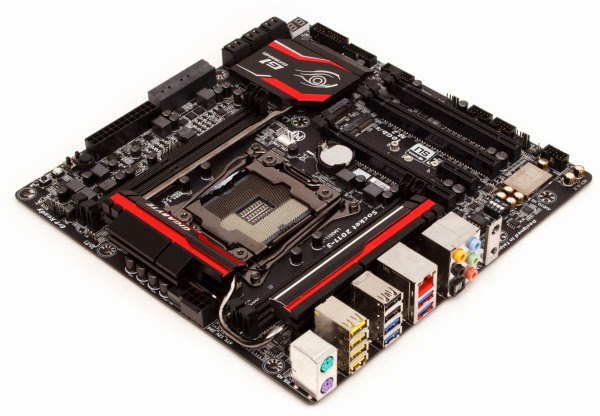We’ve covered a lot of small form factor hardware in recent months, and the GIGABYTE GA-X99M-Gaming 5 might be the best of the bunch. GIGABYTE shrinks the X99 chipset down to the mATX form factor, so you’ll be able to use Haswell-E processors and quad-channel DDR4 in your portable gaming rig. This tiny powerhouse also supports 2-way SLI and CrossFire, PCI-E storage devices (via both a SATA Express and M.2), and GIGABYTE’s AMP-UP Audio Technology. Designing a potent SFF system should be no problem with this motherboard.
Overclockers will like that the GAX99M-Gaming 5 uses the all-digital power design found on GIGABYTE’s full-sized X99-Gaming lineup. For example, International Rectifier digital PWM controllers and PowIRstage ICs provide precise power to your Haswell-E processor. For server-level reliability, GIGABYTE uses Cooper Bussmann chokes and high-quality solid state capacitors. The exceptional power-handling features will help power users get the most out of Intel’s latest Extreme Edition processors.
Any motherboard geared toward gamers needs to deliver support for multiple high-end graphics cards. The GA-X99M-Gaming 5 allows both cards in a 2-way SLI or CrossFire setup to run at the full x16 speed (when paired with the 40 PCI-E lane Core i7-5960X or i7-5930K). GIGABYTE actually manages to fit three PCI-E x16 slots on this motherboard, but the spacing means you’ll only be able to install two dual-slot GPUs—still impressive for a mATX motherboard.
High-speed DDR4 is no problem for the GA-X99M-Gaming 5. It supports speeds up to 2,800MHz, and you can install up to 32GB in the motherboard’s four DIMM slots. GIGABYTE also covers the GA-X99M-Gaming 5 for current and future storage options. For SATA-based storage, there are 10 6Gbps SATA ports, six of which support RAID 0/1/5/10 configurations. 10Gbps PCI-E storage devices are supported by the SATA Express and M.2 ports (type 2242/2260/2280). These two ports share bandwidth, so you’ll only be able to use one or the other.
In a SFF build, a dedicated sound card takes up valuable space. The GAX99M-Gaming 5’s stellar onboard audio circumvents the need for additional audio processing. It starts from the ground up with Nichicon professional audio capacitors. You can tailor the sound to suit your audio preferences, thanks to GIGABYTE’s upgradable OP-AMP. Onboard gain switches let you increase amplification from 2.5X (for conventional headphones and speakers) to 6X (for high impedance audio gear). The GA-X99MGaming 5 also protects the audio signal on its way to the rear I/O by separating the left and right audio channels, which eliminates channel crosstalk.
To ensure clean audio delivery from the USB port, GIGABYTE includes four USB 2.0 ports with an isolated power source to minimize potential power fluctuations and reduce noise that can affect audio quality. GIGABYTE color-codes the USB ports gold, so it’s easy to distinguish the noise-free ports. For sound processing, the GAX99M-Gaming 5 uses Realtek’s ALC1150 HD audio codec. It supports up to 7.1-channel surround sound, as well as the latest in microphone array technology, including echo cancellation and noise suppression.
Competing network traffic can cause major issues with online games. GIGABYTE includes Killer’s E2200 NIC to let you manage network bandwidth and determine that the problem isn’t on your end. The E2200 also features Killer’s Advanced Stream Detect technology, which automatically prioritizes network traffic to reduce in-game latency, so your games should be optimized without any input from you. To provide a way to add wireless networking without taking up an expansion slot, the GA-X99M-Gaming 5 also offers an M.2 port (socket 1) that’s designed for Wi-Fi and Bluetooth modules.
Having tested one of GIGABYTE’s X99-Gaming motherboards before (the GA-X99-Gaming G1 WIFI), we expected the GA-X99M-Gaming 5 to do well. It certainly lived up to expectations, with 65.3fps and a score of 1684 in Unigine’s Heaven 4.0 test. Other good numbers, compared to other X99 motherboards we’ve reviewed, were 2821.03 pixels per second in POV-Ray 3.7 and 1397 points in Cinebench 15—both are processor-intensive tests. In our game tests, the GA-X99-Gaming 5 delivered 56.67fps in Metro: Last Light and 61fps in Aliens vs. Predator. As you can see, the mATX form factor doesn’t limit the motherboard’s performance.
If you’ve resisted SFF systems in the past due to performance qualms, GAX99M-Gaming 5 might change your mind. Compared to GIGABYTE’s E-ATX X99 motherboard, very few features are sacrificed. We even selected the GA-X99M-Gaming 5 for our system giveaway build going to PAX South. In the case of this motherboard, size matters not. BY NATHAN LAKE
Specs: Max Memory: 32GB DDR4 (DDR4-2133; Max OC: DD4-2800); Slots: 3 PCI-E x16, 1 PCI-E x1; Storage: 10 6Gbps SATA, 1 SATA Express, 1 M.2 (type
2242/2260/2280); Rear I/O: 4 USB 3.0, 6 USB 2.0, 2 PS/2, 1 optical S/PDIF out, audio I/O, 1 Gigabit Ethernet; Form factor: mATX; Warranty: 3 years
